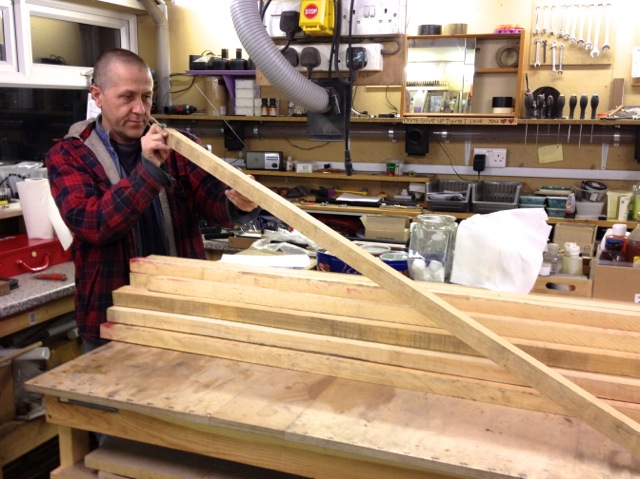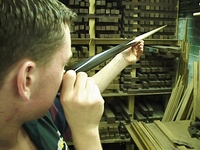How To...

...Check for straightness
Look down the cue like this:

Bends can be easily seen. Simple.
How not to check
- Do not roll a cue on a table.
- Why? Because it is possible for a bent cue to appear straight, and a straight cue to appear bent (trust me - I've seen it)
Whilst it is obviously important for a cue to be straight, this is an area of confusion and misunderstanding.
People expect their cue to be straight, and quite rightly so, but it's an issue that needs to be understood and kept in context. The point is, a small bend in a cue does not make it a bad cue and does not affect cueing in any way. Nor does it mean it is faulty.
If you roll a cue on a table it may 'wobble' and appear bent. Often, it can be the way the butt is shaped that causes this, other times it can be caused by small discrepancies in the shaft taper. Either way, the cue could be perfect for you but you tell yourself it is no good because it is 'bent'.
You must forgive the wood a little and allow a cue its personality. Sure, it may have a slight kink or bump somewhere, but it could feel superb to play with. A cue that looks straight enough and plays well is better than a dead straight lifeless piece of wood any day of the week.
So, get your priorities right and judge the cue on that factor alone.
My cue has bent, I cannot play anymore!
Your cue may have rolled straight once, then 6 months, 1 year, 5 years later, you roll it again and it now wobbles slightly. Does it really matter if it has moved a little bit? Of course not. Plus, a millimetre here or there can create the effect of a large bend when, in reality, if you sight down the cue, it still looks straight
Remember - A small bend will never affect your ability to pot a ball. This is solely down to your eyesight and cue action. Give the cue a break, and do not find excuses for your poor playing by blaming your bent cue.
Of course, if you left your cue by a radiator and it's severely bent, that's a different story altogether and needs rectifying...
The following information should help you understand much better what goes into making a cue and what to expect from a cue once it is made.
Making a straight cue
In making a cue, certain procedures need to be taken to ensure that a cue stays as straight as possible.
The timber must be seasoned thoroughly. If the wood has not had time to settle during manufacture, it is highly likely that it will bend after it has been made. Storing the wood for a long time before using it allows the wood a chance to dry slowly and naturally. Some wood has been stored for 10+ years.
Each cue is checked by eye for any bends/kinks at every stage of manufacture. Any bends are planed out so that any natural stresses are removed from the wood in a slow and controlled state.
This time consuming process results in cues that are very stable. Which means your cue will stay as straight as possible. Having said this, no cue can be guaranteed to stay straight. There are many factors that than cause a perfectly straight cue to bend, from general climatic changes to how you store your cue.
Cues that are mass produced are far more likely to bend due to the way in which they are made. Often they are turned, in one pass, from square timber to a tapered shaft. This is quite an impressive sight, but the wood has been given no chance to settle. Future bending is almost guaranteed, some quite spectacular!
Understanding cue stability
The first thing you must understand is that wood is natural and is affected by changes in temperature/climate etc..
Many mass produced cues are made far too quickly, using timber that is not seasoned well enough, which can consequently cause severe warping. This should not be confused with the small movement in wood that can occur in even the most mature, well seasoned cues.
A cue must be made slowly enough for the wood to settle in stages so that any bends that occur, due to natural stresses in the wood, can be removed before the cue is finished. This time consuming process will ensure that the wood is very stable, and means your cue will stay as straight as possible.
But, having said this, no cue can be guaranteed to stay straight. There are many factors that than cause a perfectly straight cue to bend, from general climatic changes to how you store your cue.
Many people expect a cue to be perfectly straight, but is this reasonable? Think about it ? we are talking about a piece of wood nearly 5ft long, around 30mm thick at the bottom, tapering down to 10mm or less...
Sure, a cue when first made can be perfectly straight, but none of us should be surprised or disappointed if it moves slightly in time, as it settles in it??s new environment.
In fact, it amazes me how we actually manage to keep the cues as straight as we do.
Keeping a cue straight
These guidelines should help keep your cue as straight as possible:
The Dos
- Keep your cue in a case when not use. This will help to protect and prevent possible issues.
- Try to keep your cue in a stable environment. Avoid extreme changes in temperature/humidity wherever possible.
The Do Nots
- Lean your cue at an angle against the wall, or leave it near heat, e.g. a radiator. This is a sure-fire way of warping your cue!
- Leave your cue in your car, or anywhere else that is likely to get cold or damp. This can cause the cue to 'sweat' and become very sticky, as well as cause any glue joins to raise, and possibly cause it to bend.
- Both of these also apply even if the cue is stored in a case. The heat/cold/climate will get into the case and therefore possibly affect the wood.
But always bear in mind that the cue can still move a little no matter how well you look after it.
It's wood - That's what wood does.
Conclusion
- If you sight down the cue and it appears straight - be happy.
- If you don't immediately see an obvious warp, and it feels straight, then get on with your game.
- A cue is a long thin piece of wood. We obviously want it straight but sometimes it can be bend slightly. Does it matter? No. It will not affect your ability to pot balls one tiny little bit.
- A dead straight cue will not help you make a hundred break. That is purely down to the way you hit the ball.
- Focus on the more important issues, like how the cue actually feels when you play a shot. If you spend your time hunting for perfect straightness, your mind is not in the right place.
Don't get me wrong, a cue should look and feel straight. I am just pointing out the facts, and trying to help you concentrate on what really matters.
If you worry about the cue 'wobbling' when you roll it on the table, it will just put seeds of doubt in your mind and you will start blaming the cue when it's your cue action at fault.

